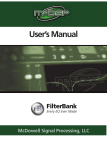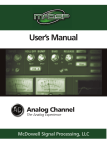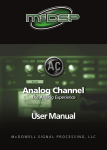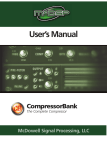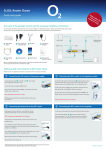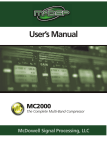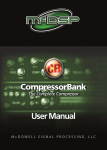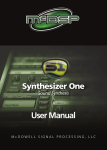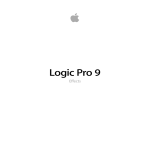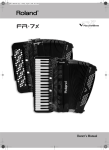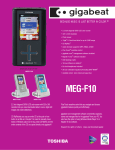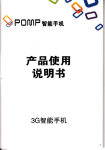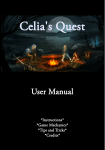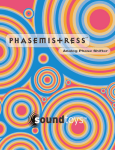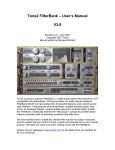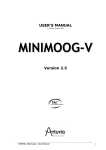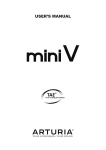Download User Manual
Transcript
User Manual McDOWELL SIGNAL PROCESSING, LLC McDSP FilterBank Plug-In Manual McDSP McDowell Signal Processing, LLC 1300 Crittenden Lane #401 Mountain View, CA 94043 Support Email: [email protected] Technical Support: [email protected] World Wide Web: www.mcdsp.com Page ii McDSP FilterBank Special Thanks to: • Daniel Caccavo, Will Catterson, Mikail Graham, Andy Gray, Jonathan Goldstein, Rhett Lawrence, and Dave Pensado, and the rest of our great beta team for their invaluable input and feedback • Dr. Robert E. Filman and Tom McTavish for the tech-talk and encouragement • Florian Richter, Ken Walden, and the many other ‘tape sat’ solicitors • Frank Filipanits, Jr. for the GeneratorX plug-in his additional assistance with the abundance of details in bringing a software product to market • David Denny and Stephen Jarvis for the rental on the great gear • Jay McKnight, at Magnetic Reference Laboratory for his expert commentary and vast catalog of papers on audio engineering • Jack Endino (www.endino.com) for providing some measurements of various analog tape ‘reproducers’ he has worked with over the course of his career, • Rob Barrett, Jr. our #1 customer from the entire McDSP development team. Copyright Notice: Copyright 1998-2009 McDowell Signal Processing, Limited Liability Company All Rights Reserved. The McDowell Signal Processing, Limited Liability Company’s FilterBank Plug-In and corresponding User’s Manual is copyrighted and all rights are reserved. Information in this document is subject to change without notice and does not represent a commitment on the part of McDowell Signal Processing, Limited Liability Company. This document may not, in whole or part, be copied, photocopied, reproduced, translated, or reduced to any electronic medium or machine-readable form for the purpose of resale without prior consent, in writing, from McDowell Signal Processing, Limited Liability Company. Trademarks: McDowell Signal Processing, Limited Liability Company is a trademark of McDowell Signal Processing, Limited Liability Company. Other brands and their products are trademarks of their respective holders and should be noted as such. Digidesign™ and Pro Tools™ are registered trademarks of Digidesign, Inc. mcdsp.com Page iii Table of Contents McDSP FilterBank Plug-In Manual McDSP License Agreement Getting Started with FilterBank System Requirements Installing the FilterBank Plug-In Installation on Mac OS X Installation on Windows XP and Vista Installation on VENUE D-SHOW systems Authorizing your McDSP Plug-Ins Authorizing with a pre-programmed iLok Smart Key Authorizing with an iLok License Card Authorizing with iLok.com Registering your McDSP Plug-In Using your McDSP Plug-Ins FilterBank FilterBank’s Innovative P-S-D (Peak-Slope-Dip) Control Quick Start to FilterBank Getting Started FilterBank E6 Overview The Controls Low and High Shelf EQs: Parametric EQ: Low and High Pass Filters: Control Linking User Interface Preference Setting Alternate Knob User Interface The Display Graph The Meter Automation Using presets and making your own Page iv ii vi viii viii x x xii xiv xvi xvi xvi xx xxiii xxiii 1 2 3 3 3 5 5 5 5 7 8 8 8 8 9 9 McDSP FilterBank Using Filter Bank Low and High Shelving Equalizers Parametric Equalizer Low and High Pass Filters BandPass-BandStop Filters Input Control Metering Modeling Analog Equalizers with FilterBank Neve™ and FilterBank’s E-classic1 preset Avalon 2055™ and FilterBank’s P-classic2 preset GML8200™ and FilterBank’s P-classic3 FilterBank’s Smooth Tubes 1 & 2 presets FilterBank Presets FilterBank Configurations and Specifications Specifications for E2 Mono & Stereo: Visual Reference for E2 Specifications for E4 Mono & Stereo: Visual Reference for E4 Specifications for E6 Mono & Stereo: Visual Reference for E6 Specification for F1 Mono & Stereo: Visual Reference for F1 Specification for F2 Mono & Stereo: Visual Reference for F2 Specification for F3 Mono & Stereo: Visual Reference for F3 Specifications for P2 Mono & Stereo: Visual Reference for P2 Specifications for P4 Mono & Stereo: Visual Reference for P4 Specifications for P6 Mono & Stereo: Visual Reference for P6 Specifications for B1 Mono & Stereo: Visual Reference for B1 FilterBank Linked Control Table FilterBank DSP Usage Table 10 10 11 12 13 14 14 15 15 17 18 18 19 20 21 22 23 24 25 26 27 28 29 30 31 32 33 34 35 36 37 38 39 40 41 42 FilterBank Frequently Asked Questions 43 mcdsp.com Page v McDSP License Agreement The software described in this manual is furnished under a license agreement and may be used only in accordance with the terms of the agreement. McDowell Signal Processing, Limited Liability Company License and Warranty: The software which accompanies this license (the “Software”) is the property of McDowell Signal Processing, Limited Liability Company or its licensers and is protected by copyright law. While McDowell Signal Processing, Limited Liability Company continues to own the Software, you will have certain rights to use the Software after your acceptance of this license. Except as may be modified by a license addendum which accompanies this license, your rights and obligations with respect to the use of this Software are as follows: You May: • authorize 1 (one) copy of the Software on 1 (one) PACE Anti-Piracy iLok USB Smart Key, for use with no more than 1 (one) computer at any given time; • make copies of the Software for archival purposes, or copy the software onto the hard disk of your computer and retrain the original for archival purposes; • after written notice to McDowell Signal Processing, Limited Liability Company, transfer the Software on a permanent basis to another person or entity, provided that you retain no copies of the Software and the transferee agrees to the terms of this agreement You may not: • copy, duplicate, or reproduce the documentation which accompanies the Software for the purpose of resale; • sublicense, rent or lease any portion of the Software to a third party without expressed written permission from McDowell Signal Processing, LLC; • reverse engineer, de-compile, disassemble, modify, translate, make any attempt to discover the source code of the Software, or create derivative works from the Software; • make any attempt to circumvent any copy protection software; • use a previous version or copy of the Software after you have received a replacement set or an upgraded version as a replacement of the prior version, unless you donate a previous version of an upgraded version to a charity of your choice, and such charity agrees in writing that it will be the sole end user of the product , and that it will abide by the terms of this agreement. Unless you so donate a previous version of an upgraded version, upon upgrading the Software, all copies of the prior version must be destroyed. Page vi McDSP Limited Warranty: McDowell Signal Processing, Limited Liability Company warrants that the media on which the Software is distributed will be free from defects. Your sole remedy in the event of a breach of this warranty will be that McDowell Signal Processing, Limited Liability Company will, at its option, replace any defective media. McDowell Signal Processing, Limited Liability Company does not warrant that the Software will meet your requirements or that the operation of the Software will be uninterrupted or that the Software will be error-free. THE ABOVE WARRANTY IS EXCLUSIVE AND IN LIEU OF ALL OTHER WARRANTIES, WHETHER EXPRESSED OR IMPLIED, INCLUDING THE IMPLIED WARRANTIES OF MERCHANTABILITY, FITNESS FOR A PARTICULAR PURPOSE AND NON INFRINGEMENT. THIS WARRANTY GIVES YOU SPECIFIC LEGAL RIGHTS. YOU MAY HAVE OTHER RIGHTS, WHICH VARY FROM STATE TO STATE. Disclaimer of Damages: REGARDLESS OF WHETHER ANY REMEDY SET FORTH HEREIN FAILS OF ITS ESSENTIAL PURPOSE, IN NO EVENT WILL McDowell Signal Processing, Limited Liability Company BE LIABLE TO YOU FOR ANY SPECIAL, CONSEQUENTIAL, INDIRECT OR SIMILAR DAMAGES, INCLUDING ANY LOST PROFITS OR LOST DATA ARISING OUT OF THE USE OR INABILITY TO USE THE SOFTWARE EVEN IF McDowell Signal Processing, Limited Liability Company HAS BEEN ADVISED OF THE POSSIBILITY OF SUCH DAMAGES. SOME STATES DO NOT ALLOW THE LIMITATION OR EXCLUSION OF LIABILITY FOR INCIDENTAL OR CONSEQUENTIAL DAMAGES SO THE ABOVE LIMITATION OR EXCLUSION MAY NOT APPLY TO YOU. IN NO CASE SHALL McDowell Signal Processing, Limited Liability Company’s LIABILITY EXCEED THE PURCHASE PRICE FOR THE SOFTWARE. The disclaimers and limitations set forth above will apply regardless of whether you accept the Software. U.S. Government Restricted Rights: RESTRICTED RIGHTS LEGEND: Use, duplication, or disclosure by the Government is subject to restrictions as set forth in subparagraph (c) (1)(ii) of the Rights in Technical Data and Computer Software clause at DFARS 252.227-7013 or subparagraphs (c)(1) and (2) of the Commercial Software Restricted Rights clause at 48 CFR 52.227-19, as applicable, McDowell Signal Processing, Limited Liability Company, Mountain View, CA 94043 ([email protected]). General: This Agreement will be governed by the laws of the State of California. This Agreement may only be modified by a license addendum which accompanies this license or by a written document which has been signed both by you and McDowell Signal Processing, Limited Liability Company. Should you have any questions concerning this Agreement, or if you desire to contact McDowell Signal Processing, Limited Liability Company for any reason, please email: [email protected]. By downloading, using, or copying this Binary Software, Licensee agrees to abide by the intellectual property laws, and all other applicable laws of the U.S., and the terms of this License. Ownership of the software shall remain solely in McDowell Signal Processing, Limited Liability Company. mcdsp.com Page vii Getting Started with FilterBank Each McDSP plug-in is delivered inside an installer application, and uses the Interlok copy protection software to authorize each plug-in. This section describes how to install and authorize a McDSP plug-in. General system requirements are also described. System Requirements McDSP HD, Native, and LE plug-ins are compatible with Pro Tools™ HD, HD Accel TDM systems, as well as Pro Tools™ LE and Pro Tools™ M-Powered host based systems. McDSP plug-ins support Mac OS 10.4.x (Tiger), 10.5.x (Leopard), Windows XP and Vista, and require Pro Tools 7.x, 8.x or greater. McDSP plug-ins require an iLok USB Smart Key. Configurations McDSP plug-ins are available in TDM, RTAS, and AudioSuite configurations. See individual products for specific available configuration sets. Applications Pro Tools™ 7.x, 8.x or higher is required for TDM, LE, and M-Powered systems. Additionally, a third party software application that supports the Digidesign TDM, RTAS, or AudioSuite plug-in standard may be supported. See http://www. digidesign.com/developers/plugin_info/ for more information. McDSP plug-ins are compatible with the entire Pro Tools™ 7 and 8 product line. Hardware McDSP plug-ins support any Digidesign or approved third party hardware supported in Pro Tools™ 7.x and 8.x. This includes HD, HD Accel, 003, and Mbox host based systems. All McDSP HD plug-ins, except Synthesizer One, also support the Digidesign VENUE D-SHOW systems. See http://www.digidesign.com/ compato/ for more specific information. The McDSP Mac versions are compatible with both Intel and PowerPC based computers. The McDSP Windows versions require an Intel Pentium 4 or greater processor.* Page viii Getting Started * McDSP Windows test machines are chosen to follow the Digidesign recommended systems guide, which currently is the Dell Precision™ Workstation 670 with 2.79 GHz Xeon processor. All products are guaranteed to run on that system. Older Intel processors (i.e. Pentium III and predecessors) and AMD processors are not officially supported, although some users have had limited success with newer AMD processors (i.e. Dual Opteron 1.79 GHZ, Athlon 64 2.20 GHz, and Athlon 64 XP 3700). None of McDSP Windows product line will work with Pro Tools™ 5.x. Also note the McDSP Windows product line does not support MIX, although RTAS versions will work if they exist and the rest of your system (i.e. Pro Tools™ version and processor) is compatible. Please visit mcdsp.com for the latest information about compatibility. mcdsp.com Page ix Installing the FilterBank Plug-In Installation on Mac OS X The FilterBank plug-in Package includes this manual, ReadMe and Release Notes, a folder of presets for the FilterBank plug-in, and the FilterBank plugin. Two copies of the FilterBank Licensing Agreement are included - one in this pdf manual and a second as a separate text file. The FilterBank plug-in manual requires that Adobe Acrobat reader (or similar .pdf reader) is installed. Both online and boxed version will come with a FilterBank installer that will automatically install the FilterBank plug-in and its presets on your system. The authorization of the FilterBank plug-in is still required after running the installer, and those steps are detailed in the following sections. Installing the FilterBank plug-in and presets with the Installer: The online version of the package has been prepared for Internet delivery, and is transmitted as a compressed file in zip format (.zip). In Mac OS X 10.4.x or 10.5.x, simply double click the *.zip file to unpack the installer. The boxed plugin package purchased at your local dealer will be on CDROM. As with the online version, these ‘physical’ versions of the FilterBank plug-in package should be copied into a local folder on your system. • Insert the McDSP ‘HD Disk,’ ‘Native Disk,’ or ‘LE Disk’ CDROM onto an available CDROM drive. • Navigate to the FilterBank plug-in folder on the CDROM - the installer application is contained therein. • Run the FilterBank plug-in Installer application to install (copy) the FilterBank plug-in, presets, and documentation to a local folder on your system. The plug-in will be placed in the ‘Plug-Ins’ folder, and the presets will be placed in the ‘Plug-Ins Settings’ folder. • If a previous version of the FilterBank plug-in (or other HD, Native, or LE version) was already in the plug-ins folder, it will automatically be updated (or replaced) by the installer. Page x Getting Started Re-installing the FilterBank plug-in presets manually: In you wish to restore the factory default presets, it may be useful to know how to manually re-install only the presets. • Go to the ‘Plug-in Settings’ folder: • Root->Library->Application Support->Digidesign->Plug-in Settings • If Pro Tools™ has not already done so for you, create a folder called ‘FilterBank’. • Place a copy of the folder from the FilterBank plug-in package called ‘Presets’ into the ‘FilterBank’ folder. The presets are now viewable (after restarting Pro Tools™) from the settings popup menu from the FilterBank plug-in. Note it may be necessary to re-start Pro Tools™ in order for the newly added ‘Presets’ folder to be viewable from the Settings popup inside the FilterBank plug-in window toolbar. mcdsp.com Page xi Installation on Windows XP and Vista The FilterBank plug-in Package includes this manual, ReadMe and Release Notes, a folder of presets for the FilterBank plug-in, and the FilterBank plug-in. Two copies of the FilterBank Licensing Agreement are included - one in this pdf manual and a second as a separate text file. The FilterBank manual requires that Adobe Acrobat reader (or similar .pdf reader) is installed. Both online and boxed version will come with a FilterBank installer that will automatically install the FilterBank plug-in and its presets on your system. The authorization of the FilterBank plug-in is still required after running the installer, and those steps are detailed in the following sections. Installing the FilterBank plug-in and presets with the Installer: The FilterBank plug-in package purchased at your local dealer will be on CDROM and contain a Windows self extracting executable (.exe) similar to the online FilterBank plug-in package prepared for Internet delivery. Both the boxed and online versions the FilterBank plug-in executable file will automatically install the plug-in and its presets on your system. Double click the file to launch the installer which will install the FilterBank plug-in, presets, and documentation. At any time after installation, you may access the documentation from the Windows ‘Start Menu’ under the ‘McDSP’ group. Authorization of the FilterBank plug-in is still required after running the installer, and those steps are detailed in the following sections. Note that after installing new versions of the PACE iLok drivers with the FilterBank plug-in installer, you will be prompted by the FilterBank plug-in installer to reboot your system. If you are not prompted by the installer, there is no need to reboot. • Insert the McDSP ‘HD Disk,’ ‘Native Disk,’ or ‘LE Disk’ CDROM onto an available CDROM drive. • Navigate to the FilterBank plug-in folder on the CDROM - the installer application is contained therein. • Run the FilterBank plug-in Installer application to install the FilterBank plugin, presets, and documentation to a local folder on your system. The plug-in will be placed in the ‘Plug-Ins’ folder, and the presets will be placed in the ‘Plug-Ins Settings’ folder. • If a previous version of the FilterBank plug-in (or other HD, Native, or LE version) was already in the plug-ins folder, it will automatically be updated (or replaced) by the installer. Page xii Getting Started Re-installing the FilterBank plug-in presets manually: In you wish to restore the factory default presets, it may be useful to know how to manually re-install only the presets. • Go to the Plug-In Settings folder: • C:\Program Files\Common Files\Digidesign\DAE\Plug-In Settings\ • If Pro Tools™ has not already done so for you, create a folder called ‘FilterBank’. • Place a copy of the folder from the FilterBank plug-in package called ‘Presets’ into the ‘FilterBank’ folder. The presets are now viewable (after restarting Pro Tools™) from the settings popup menu from the FilterBank plug-in. Note it may be necessary to re-start Pro Tools™ in order for the newly added ‘Presets’ folder to be viewable from the Settings popup inside the FilterBank plug-in window toolbar. mcdsp.com Page xiii Installation on VENUE D-SHOW systems The FilterBank plug-in Package for VENUE D-SHOW systems includes presets for the FilterBank plug-in and the FilterBank plug-in. The FilterBank Licensing Agreement is displayed when installing the product on D-SHOW. The pdf manual can be obtained by running the Mac OS X or Windows XP/Vista version of the FilterBank Pro Tools plug-in installer on any available computer. Both online and boxed versions will come with a VENUE compatible installer that will automatically install the FilterBank plug-in and its presets on your system. The authorization of the FilterBank plug-in is still required after running the installer, and those steps are detailed in the following sections. Note that all McDSP HD plug-ins, except Synthesizer One support the Digidesign VENUE D-SHOW system. Installing the FilterBank plug-in and presets on VENUE with the ‘HD Disk’: The boxed FilterBank plug-in package purchased at your local dealer will contain a CDROM titled ‘HD Disk’ that is specially formatted to work with your VENUE console. The VENUE installers are also available online as a compressed zip file download, however you will have to take additional steps to create your own VENUE installer CD-R, see additional instructions below before proceeding with these instructions. Both the boxed and online versions of the FilterBank installer are the same and will install both the plug-in and its presets on your system. Note that after installing new versions of the PACE iLok drivers with the FilterBank plug-in installer, you will need to reboot your system. You will not be prompted to reboot, and if you don’t you may see an error message saying “TPkd driver required, and a reboot. Please reboot or reinstall the software.’ If you see this message, simply reboot the console and try again. • Insert the McDSP ‘HD Disk’ CDROM onto the CD drive. Note that neither the McDSP ‘Native Disk’ nor the ‘LE Disk’ contains VENUE compatible installers. • Ensure your system is in ‘CONFIG’ mode, you cannot install plug-ins in ‘SHOW’ mode. • Navigate to the ‘OPTIONS’ page and then select the ‘PLUG-INS’ tab. • You should now see the FilterBank plug-in available on the left hand side. • Select the FilterBank plug-in and select ‘INSTALL.’ • If a previous version of the FilterBank plug-in was already installed, it will be updated by the installer. Page xiv Getting Started Important note for FilterBank HD and CompressorBank HD on VENUE D-SHOW consoles: The first time you instantiate either of these plugins, a dialog box will appear asking you to choose a user interface preference. Choose the Knobs interfaces, as some of the Slider interfaces are too large for the VENUE display. Creating a VENUE D-SHOW Installer CD-R from the online zip file: If you do not have a boxed copy of FilterBank with the included ‘HD Disk’ CDROM, you can still obtain a copy of the VENUE compatible installers from the www.mcdsp.com website. Once you have located and downloaded the latest VENUE compatible installers from the McDSP website, you will have to take several additional steps to create a VENUE compatible Installer CD-R. For your convenience, all VENUE compatible products are located in the same downloadable zip file, so you will only have to create one CD-R to install all compatible McDSP products. • Unzip the downloaded file and locate the folder named “TDM Plug-Ins” inside the unpacked folder. • Using any CD-R burning application, burn this folder and its contents to an ISO format CD-R. It is recommended that you use a brand new CD-R for this, and do not rewrite an older CD-R. • Once you have burned this folder to a CD-R, you should see it at the root level of the disk (i.e. “D:\TDM Plug-Ins”). Important: If the “TDM Plug-Ins” folder is not located at the root level of the CD-R or has been renamed, the VENUE console may not properly recognize the installer disk. • At this point, you can follow the ‘HD Disk’ installation instructions above to complete the installation. mcdsp.com Page xv Authorizing your McDSP Plug-Ins Authorizing with a pre-programmed iLok Smart Key McDSP bundles such as the Emerald Pack come with a pre-programmed iLok Smart Key. Simply insert the iLok into any available USB port on your computer. The iLok’s indicator light will illuminate when the iLok has a proper connection. The Plug-Ins included in the bundle require no further authorization steps. As with any iLok on your system it is recommended that your iLok be registered and synchronized with iLok.com Authorizing with an iLok License Card All McDSP Plug-Ins require that a valid authorization is present on your iLok USB Smart Key. McDSP Plug-ins that are purchased individually provide this authorization on a plastic License Card (about the size of a credit card), with a small punch-out iLok License Chip. After being separated from the License Card, this iLok License Chip is to be inserted into the ‘key slot’ of the iLok USB Smart Key in order to transfer the authorization from the License Card to the iLok USB Smart Key. Note that each License Card holds ONE Plug-In authorization. The following instructions detail this process Important Note: The Authorization Wizard will prompt the user to register their iLok USB Smart Key at iLok.com. iLok.com is a service offered by PACE Anti-Piracy, Inc. and this step is recommended but NOT REQUIRED by McDSP to complete the authorization of the Plug-In. If you choose to register your iLok USB Smart Key at iLok.com, care must be taken to record your ilok.com account information (i.e. write down your User ID and Password in a safe place). If your iLok.com account information is lost, the iLok cannot be registered to another account and unfortunately there is nothing McDSP can do to help you. See iLok. com for more details about the benefits of using PACE’s iLok.com service. Note: Images in this section are for illustration only, the actual product and screens will be the name of the product you are authorizing. Page xvi Authorizing Your McDSP Plug-Ins Authorizing a McDSP Plug-In from a License Card with the Authorization Wizard: The Authorization Wizard is used to install an authorization from a License Card to the iLok USB Smart Key. To use the Authorization Wizard for the Plug-In you purchase, perform the following steps: • Insert your iLok USB Smart Key into an available USB port. • On a Mac :Locate and launch the ‘Authorizer’ application found in the ‘Authorize’ folder in the Plug-In package for the McDSP Plug-In you purchased on the CD-ROM. • On Windows XP or Vista, just launch Pro Tools™ to authorize the individual McDSP Plug-In you purchased. Note: When authorizing the Plug-In on Windows XP or Vista with a new iLok USB Smart Key, you must insert the iLok USB Smart Key and complete the Windows ‘Found New Hardware Wizard’ before attempting to authorize the Plug-In. • Select the ‘Authorize’ button to be guided through the Authorization Wizard. Note: Selecting the ‘Quit’ button at any time will not authorize the Plug-In or allow it to be used for a trial period. If ‘Quit’ is selected, the Plug-In will not be available in the Pro Tools™ insert menu. • McDSP Plug-Ins require that the user personalize their copy of the Plug-In. A dialog is displayed soliciting this information. Note that the product registration card enclosed with the Plug-In MUST ALSO be filled out as well and returned to McDSP via mail (or fax to 707-2200994). This additional mail-in registration will entitle the user to future upgrades and advance information from McDSP. mcdsp.com Page xvii • Once the Plug-In is personalized, click the ‘Next’ button to continue. • Check the ‘Use License Card’ box and press the ‘Next’ button (figure 2.3). Note: Although the Authorization Wizard may appear to allow authorization by challenge/ response, that method is currently NOT SUPPORTED McDSP Plug-Ins. • Separate the small punch-out iLok License Chip (the removable metal and plastic tab) from the License Card by pushing the cutout up and out with your thumb. Do not force your finger downward. • The iLok License Chip may now be inserted into the ‘key slot’ of the iLok USB Smart Key (figure 2.6). If the iLok USB Smart Key does not appear to be present on the system, ensure the iLok USB Smart Key is connected to a valid USB port and that the green LED is lit inside the iLok USB Smart Key. To insert the License Chip into the iLok USB Smart Key, orient the iLok USB Smart Key’s USB end to the left, and the loop end to the upper right. Insert the metal chip end of the iLok License Chip (the License Chip tab should have the metal chip side facing up towards you, not down). You should be able to visually verify that the License Chip makes contact with the iLok USB Smart Key metal card reader. • The green LED in the iLok USB Smart Key will light when it is ready to receive and transmit data. • Upon inserting the iLok License Chip, a message will be displayed indicating the authorization was installed successfully. Click ‘Ok’ in the message dialog. Page xviii Authorizing Your McDSP Plug-Ins • Once the authorization is installed on the iLok USB Smart Key, a dialog is displayed prompting the user to register their iLok USB Smart Key at the www.ilok.com website. The iLok.com website was created to allow users to manage the software authorizations on their iLok USB Smart Key. THIS STEP IS NOT REQUIRED TO COMPLETE THE AUTHORIZATION OF MCDSP SOFTWARE. The registration of the iLok USB Smart Key to an iLok.com account can be bypassed by clearing the checkbox. The user may also choose to not be asked to register again. While iLok.com is a great resource for the iLok USB Smart Key, your iLok USB Smart Key may only be linked to one iLok.com account. That is, an individual iLok USB Smart Key can only be registered to one account at a time--but a single account can have multiple iLok USB Smart Keys. If the iLok.com account information is lost, the iLok USB Smart Key cannot be registered to another account. However, an iLok USB Smart Key may be transferred between accounts if all the authorizations have been transferred off the iLok USB Smart Key. Register the iLok USB Smart Key to an iLok.com account only when you are ready to retain all the needed iLok.com account information (User ID and Password). • A ‘Finished’ dialog is displayed showing what authorization method was used. • Click ‘Finish’ to exit the Authorization Wizard. mcdsp.com Page xix Authorizing with iLok.com Required for demo, upgrade, and replacement authorizations only iLok.com can be accessed from any Macintosh or PC with an Internet connection. You can do this at home, a friend’s, or at the office as long as there is an internet connection to access iLok.com--note that you don’t have to use your ProTools system computer! You simply use this computer to connect to iLok.com and transfer authorizations to your iLok Smart Key. The iLok Smart Key can then be moved to your ProTools system to complete authorization of your Plug-In. You will need: • A computer with an Internet connection. Either a Macintosh running OS 9.2 to OS 10.3 or a PC running Windows 98, ME, 2000, XP, or Vista • An iLok USB Smart Key • A valid iLok.com account. Visit www.iLok.com and set up a free account, if you have not already done so. 1) Download and install the required client software from iLok.com. 2) Download the desired McDSP Plug-In Installer from: http://www.mcdsp.com/support/updating.html 3) To receive an upgrade or replacement authorization, send email your iLok. com account information to: [email protected] To receive a demo authorization, email your iLok.com account information to: [email protected] Insert your iLok Smart Key into an available USB port and ensure that the indicator light is lit. Once your demo, upgrade, or replacement authorization is available for transfer, your iLok.com account will display the notice saying “You have licenses” on the upper left. Begin by selecting that link. Page xx Authorizing Your McDSP Plug-Ins The next page will display the pending licenses available for download. This page will also display the name of the Plug-In, its manufacturer, the type of authorization (demo, Not For Resale, or License), the date the authorization was deposited, and the date when the authorization will no longer be available for download from the server. Before any transfer of authorizations can take place, you must synchonize your iLok Smart Key with iLok. com. This may take a moment to process depending on your internet connection. Once you have synchronized your iLok, you can select the authorization(s) you wish to transfer to your iLok. If you have multiple iLoks connected to your computer, it is important to select the correct iLok you wish the authorizations to be transferred to. Then click “Download Licenses” to begin the process. Again, this may take a moment depending on your internet connection. When the transfer finishes you will be asked to confirm the completition of the transaction, thereby letting you know that the transfer was successful. mcdsp.com Page xxi If you wish to go back into your account and visually confirm the transaction for yourself, select “View iLoks” Then select the iLok you had the authorizations transferred to. That’s it! Dont forget to logout and move the iLok Smart Key to your ProTools System if you are using another computer for Internet access. Also, you may need to install a different version of the Plug-In if you are upgrading or replacing. Transferring Authorizations with iLok.com You may freely transfer any authorization within your iLok.com account between any of your registered iLok Smart Keys. If you wish to transfer an authorization out of your iLok.com account to a different user, it will require additional support from PACE Anti-Piracy, Inc and may be subject to a service fee or limited by manufacturer restrictions. Check the www.ilok.com website for updates and developments regarding iLok USB Smart Keys and the Pace Interlok Copy Protection system. Page xxii Authorizing Your McDSP Plug-Ins Registering your McDSP Plug-In To register your McDSP Plug-In, fill out and return the product registration card enclosed with the boxed Plug-In package by mail or fax 707-220-0994. Registering your product entitles you to future upgrades and advance information from McDSP. Each individual product must be registered (even if you have multiple copies), and the product must be registered to an individual, not an entity. If you represent a company it is your company’s responsibility to notify McDSP in writing if the individual who registered the Plug-In is no longer with the company. The Company must also be able to supply matching registration information to successfully transfer ownership of the Plug-In. Using your McDSP Plug-Ins Starting a McDSP Plug-In: Follow the installation, authorization, and registration instructions above, Launch Pro Tools™, and the McDSP Plug-In and its presets are ready for use. Refer to the Digidesign™ Pro Tools™ Reference Guide for details on general Plug-In operation such as automation. Exiting a McDSP Plug-In A McDSP Plug-In is exited by clicking on the desktop or other window in the DAE application running the Plug-In, closing the Plug-In window, or de-instantiating the Plug-In. Pro Tools™ sessions will save instantiated Plug-In configurations and their settings. Refer to the Digidesign™ Pro Tools™ Reference Guide for details on general Plug-In operation. Digidesign™ and Pro Tools™ are registered trademarks of Digidesign, Inc. mcdsp.com Page xxiii McDSP FilterBank FilterBank Congratulations on purchasing FilterBank, the Equalizer that distinguishes itself among EQs by giving you the most power and flexibility to emulate any other or create your own custom EQ. • Consider first the number of configurations you get in this one plug-in: High and Low Shelf EQ, Parametric EQ, High and Low pass Filters, Band Pass and Band Reject Filters all in stereo and mono versions in 2,4, and 6 band configurations. • Consider next, the maximum independent controls available to the user to define the EQ response curve. Our design philosophy is “maximum user control,” and here is the proof of our concept: • High and Low Shelving EQs: Most other EQs only allow control Frequency and Gain; a few EQs may even allow you limited control of Peak and Dip (also known as Q). Only FilterBank gives you independent control of Frequency, Gain, Peak, Slope, and Dip. No other EQ gives you so many controls and allows as much flexibility (largest range) of these controls. • Parametric EQ: frequency control range covers nearly the entire audible spectrum (20-21000 Hz).The parametric bell is up to 5 octaves wide. Constant-Q technology closely models analog parametric responses. There are 4 parametric Q modes for even greater flexibility and control. • Low and High Pass Filters: adjustable slope and resonant peak greater than 24 dB. • Band Pass and Band Reject Filters: frequency control range covers nearly the entire audible spectrum (20-21000 Hz). • Double Precision Arithmetic which keeps the noise floor at -138 dB. In contrast, it is possible in a single precision arithmetic product for the noise floor to rise significantly above the -138 dB you would expect from a 24 bit TDM bus. (See our FAQ for more information of double precision). • Analog Saturation Modeling that prevents digital clip (See our FAQ for more information on analog saturation modeling), and a minimum of 22 bands of EQ/Filters per dsp chip - compared to the typical 4-6 per hardware box! • FilterBank is compatible with ProTools and other DAW applications that support TDM, RTAS, and Audiosuite plug-in formats. The McDSP FilterBank plug-in operates on Mac OS X and Windows XP systems. mcdsp.com Page 1 Just how many configurations are there? High and Low Shelf EQ, Parametric EQ, High and Low pass Filters, Band Pass and Band Reject Filters all in stereo and mono versions in 2,4, and 6 band configurations for a total of 17 different plug-in types. See the Reference section for a complete listing of all FilterBank configurations and their specifications. FilterBank’s Innovative P-S-D (Peak-Slope-Dip) Control PSD Control gives you independent control of peak, slope, and dip. By adjusting these controls, you can emulate the response curve of every Shelving EQ ever made! The typical low shelf analog EQ response shown in blue. Some of the many low shelf EQ responses from FilterBank are shown in red. We would like to thank you for purchasing FilterBank and wish you happy signal processing! Digidesign™ and Pro Tools™ are registered trademarks of Digidesign, Inc. All other trademarks are property of their respective owners. Page 2 McDSP FilterBank Quick Start to FilterBank Getting Started Start Pro Tools™ and Instantiate FilterBank plug-in • Launch Pro Tools™ and Open a Pro Tools™ Session. • Verify the Display-> Mix Window Shows->Inserts View option is checked. • In one of the inserts, select the E6 FilterBank plug-in. • If the inserts selection does not show FilterBank plug-ins, verify that FilterBank has been installed correctly. • For more information on starting Pro Tools™ and working with plug-ins, see Digidesign’s™ Pro Tools™ Reference Guide FilterBank E6 Overview The E6 FilterBank configuration includes: Band 1: High Pass Filter Band 2: Low Shelf EQ Bands 3&4: Parametric EQs Band 5: High Shelf EQ Band 6: Low Pass Filter mcdsp.com Page 3 Low Shelf EQ Band Number Parametric EQ Band Bypass “POP-UP” Control Sliders Config Name Low Pass Filter Display Graph Meter High Pass Filter Page 4 Input & Phase Controls McDSP FilterBank The Controls Specifications of Each EQ and Filter: Low and High Shelf EQs: Band2: Low Shelf EQ: Gain: +/- 12 dB (up to 17 dB at full peaking) Freq: 20-5000 Hz (LS), 5000-21000 Hz (HS) Peak: 0-100% (up to 5 dB of peak) Slope: 0-100% (6 dB/oct to 12 dB/oct) Dip: 0-100% (up to 5 dB of dip) Parametric EQ: Band4: Parametric EQ: Gain: +/- 12 dB Freq: 20-21000 Hz Q: 0.2- 4.0 The Parametric configurations (P2, P4, and P6) have different Q modes: Normal (original), Notch, Gain-dependent, and 5x Q. Low and High Pass Filters: Band1: High Pass Filter: Freq: 20-21000 Hz Slope: -6, -12 dB/oct mcdsp.com Page 5 To adjust any of the controls with sliders (including the pop-up sliders for Peak, Slope, and Dip), you can: • Click and drag the sliders, or • Hold the <Command> key while dragging the slider for fine control, or • Click on the text box to highlight and edit the numeric value to get precise control (if a value outside the valid range is input, the control will default to the nearest allowed value when enter is hit) and hit <Enter>, or • Click on the text box to highlight the numeric value and then use the arrow keys to increase or decrease the numeric value, or • Use the <Option> key to bring all the controls to their default values, or • Use hardware controller surfaces supported by FilterBank including the Mackie HUI and Digidesign’s ProControl™ and Control-24 To adjust any of the controls with knobs (see the following sections about User Interface preferences to find out more about the alternate knob based UI), you can: • Click and drag the knobs (note the knob will respond to left/right or up/down mouse movement, and will lock to the left/right or up/down movement once the mouse is dragged beyond the knob graphic - this significantly reduces control jittering commonly found in knob controls), or • Hold the <Command> key while dragging the knobs for fine control, or • Click on the text box to highlight and edit the numeric value to get precise control (if a value outside the valid range is input, the control will default to the nearest allowed value when enter is hit) and hit <Enter>, or • Click on the text box to highlight the numeric value and then use the arrow keys to increase or decrease the numeric value, or • Use the <Option> key to bring all the controls to their default values, or • Use hardware controller surfaces supported by FilterBank including the Mackie HUI and Digidesign’s ProControl ™ and Control-24 High and Low Pass Filters Slope Control: click the radio buttons to select a slope (dB/oct). Bypass Control Button for each EQ/Filter: this is a toggle control that takes the EQ/Filter ‘in’ or ‘out’ of the audio processing path. • The green light indicates the EQ/Filter is in; • The red light indicates the EQ/Filter is disabled by the Pro Tools™ master Page 6 McDSP FilterBank bypass button and cannot be changed without the Pro Tools™ master bypass being toggled. • When the light is off, the EQ/filter is bypassed. Control Linking To Link Right and Left Controls of Stereo Versions: • Hold the <Shift> key while adjusting any one of the left controls (or right controls); note how the right control automatically adjusts with the left control, or • to link controls without holding the <Shift> key, select the Stereo radio button in the Input section. Adjust one of the left controls and note how the right control automatically adjusts to be equal with the left control (for example, if you adjust the left gain to be equal to 6 dB, the right gain will equal 6 dB too), or • to link controls without holding the <Shift> key, select the Link radio button in the Input section. Adjust one of the left controls and note how the right control automatically adjusts relative to the left control (for example, if you adjust the left gain to increase by 2 dB, the right gain will increase by 2 dB. Unlike the Stereo radio button, this type of linking will allow the left and right controls to have different values). Note: frequency is measured on a logarithmic scale; this means the relative adjustments are not computed on a 1:1 ratio. • To disable automatic linking, select the Dual radio button in the Input section. To Link Like-Controls (for example, to link the Slope Controls of the High Shelf and Low Shelf EQ): • Hold the <Control> key on Mac, <Windows> key on Windows XP, while adjusting the one of the controls of the Low Shelf EQ; note how the corresponding control of the High Shelf EQ automatically adjusts. You can link Right/Left Stereo Controls while linking Like-Controls by holding the <Shift> and <Control> key on Mac, <Shift> and <Windows> key on Windows XP, while adjusting controls. A table listing all the control linking capabilities is provided in the reference section at the end of this manual. mcdsp.com Page 7 User Interface Preference Setting FilterBank comes with two User Interface (UI) sets. The original slider based UI is the default settings preference. The other is a knob based UI. These UI preferences are discussed in further detail in the sections below. When FilterBank is loaded during ProTools launch - a dialog is displayed asking the user what is to be the UI preference for FilterBank. There is also a “Don’t Ask Again!” box that can be checked, and the UI preference dialog will no longer appear. The dialog can be re-displayed at will (even if the “Don’t Ask Again” box was previously checked) by holding the <U> and <I> keys (together) while instantiating the FilterBank plug-in (any configuration). When the session is closed, the FilterBank plug-in saves which UI type was last used as a preference. Alternate Knob User Interface FilterBank also comes with a complete set of knob based UIs. The knobs can be operated by clicking and dragging the mouse left/right or up/down. Note the mouse movement is ‘locked’ to the left/right or up/down movement once the mouse position goes outside of the knob graphic. This reduces control ‘jitters’ significantly, and allows the knob to be functionally equivalent to a slider. As with the sliders, holding the <command> key on Mac or <Ctrl> key on Windows XP while adjusting the knob will allow fine control, and clicking the knob while holding the <option> key on Mac or <Alt> key on XP will return the knob to its default value. The Display Graph The Display Graph represents the entire frequency response of all enabled EQ/ filter bands. To toggle the frequency vs. dB grid displayed with the graph, hold the <Control> key on Mac, <Windows> key on Windows XP, while clicking on the graph. The Meter Each white hash mark represents a change of 3 dB; the top hash mark represents 0 dB. Click on the button below the Meter to select which band is monitored. The default is “out” which meters the final output. The Peak Meter lights when the signal is about to clip. The peak meter can be cleared by clicking on it with the mouse. Page 8 McDSP FilterBank Automation All FilterBank Controls are completely automatable. See the Digidesign™ Pro Tools™ Reference Guide, Automating plug-ins section. Here are a few tips about automating the stereo versions of FilterBank configurations: • If stereo or linked automation is desired for a left/right control pair, you only need to automate ONE of the left/right control pair. The stereo or link offset is preserved during automation playback. You may automate both left and right controls simultaneously, however the automation data is simply duplicated in the left and right control pair. • If discrete automation is desired for a left/right control pair, then the FilterBank control mode should be set to ‘Dual’. This will allow each left/ right control to operate independently, and not also send automation events to each other as is the case when the FilterBank control mode is set to ‘Stereo’ or ‘Link’. Using presets and making your own The FilterBank presets are inspired by EQs such as the Neve 1084™ , Avalon 2055™ , GML 8200™ , Manley™ and Pultec™. The presets can be accessed from the Pro Tools™ “plug-in Librarian” and “plug-in Settings” pop-up menus. To make and save your own presets, see the “plug-in Librarian Functions” section of Digidesign™‘s DigiRack plug-ins Guide. A Word on Preset Compatibility: Presets for the E, F, and P configurations are interchangeable between the 2, 4, and 6 band configurations but are not cross-compatible with each other. For example, a preset created with an E2 can be used in E4 and E6 (mono and stereo), however, it cannot be used in a P or F configuration (such as P2, P4, P6). If an incompatible preset is used, FilterBank will display a warning message in the version text in the FilterBank UI accompanied by a system beep. For more information, see Chapter 4: Modeling Analog Equalizers. *All Trademarks are property of their respective owners. Neve 1084™ is a trademark of AMS Neve; Avalon 2055™ is a trademark of Avalon Design; GML 8200™ is a trademark of George Massenberg Laboratories;Manley™ is a trademark of Manley Laboratories Incorporated; Pultec™ is a trademark of Pulse Technologies, Inc.; Pro Tools™ is a registered trademark of Digidesign, Inc.While FilterBank emulates the sounds of these equalizers and filters, McDSP makes no representation or warranty that FilterBank is identical to or duplicates these equalizers and filters. mcdsp.com Page 9 Using Filter Bank Low and High Shelving Equalizers The ‘E’ FilterBank configurations (E2, E4, E6) are the only configurations that have shelving equalization. In addition to having the typical gain and frequency controls, FilterBank shelving equalizers come with the unique and innovative Peak-Slope-Dip (P-S-D) control section. The P-S-D controls allow the user to model a wide variety of vintage and contemporary shelving equalizers, or customize their own shelving response. • Gain: The gain control adjusts the amount of boost or cut applied to the signal in the shelved portion of the response. • Freq: The frequency control adjusts the point in the frequency spectrum where the shelf band gain is applied. The signal amplitude at the frequency set by this control is equivalent to the amplitude set by the gain control. This control is also referred to as the shelved band frequency. • Peak: The peak control adjusts the amount of added punch in the shelved portion of the response. The peak in the shelved portion of the response gives the shelving equalizer additional brightness or emphasis near the shelved band frequency. The effective gain at the shelved band frequency can exceed the range of the gain control when used at its maximum setting. Peak and dip controls are interactive - as the peak control is increased, the overall dip in the shelved response is decreased, and vice versa. Page 10 McDSP FilterBank • Dip: The dip control adjusts the amount of warmth added in the non-shelved portion of the response. The dip in the non-shelved response reduces the amplitude of signals whose frequencies are just outside of the shelved portion of the response. Dip and peak controls are interactive - as the dip control is increased, the overall peak in the shelved response is decreased, and vice versa. • Slope: The slope control adjusts the gradient (aka slope) of the shelved response. The more gentle the transition between the shelved and nonshelved bands, the smoother the equalizer sounds. Steeper slopes can give the shelving equalizer more definition and clarity. Note that as the slope control is decreased, so are the effects of the peak and dip controls. At the minimum slope setting, peak and dip do not alter the shelving response at all. Parametric Equalizer Parametric equalization is available in the ‘E’ and ‘P’ configurations (E2, E4, E6, P2, P4, P6) of FilterBank. The flexibility and wide control range of the FilterBank parametric sections provide the user maximum control. • Gain: The gain control adjusts the amount of boost or cut applied to the signal. • Freq: The frequency control adjusts the point in the frequency spectrum where the parametric band gain is applied. The signal amplitude at the frequency set by this control is equivalent to the amplitude set by the gain control. All parametric sections are completely overlapping - the frequency range of each extends to the top and bottom of the frequency spectrum. • Q: The width of the parametric band, the bandwidth, is controlled by the Q control. Q = 1/bandwidth. Large values of Q correspond to narrow bandwidth, small values of Q correspond to wide bandwidth. FilterBank Q mcdsp.com Page 11 ranges meets or exceeds most other parametric equalizer implementations. FilterBank Q uses proprietary constant-Q technology to maintain an analog response through the entire frequency spectrum. Also note when the Q control is set to its lowest setting (0.2, i.e. 5 octave bandwidth), the equalizer response approaches that of a very smooth low or high shelf filter when the frequency control is set to extreme low and high frequency settings. This is a common characteristic in high-end parametric equalizers. • Mode: As of version 3.2, FilterBank offers different Q modes for the P2, P4, and P6 configurations: • Normal (original) - the Q values range as described above • Notch - the Q values increase 5x for negative gain, and negative gain extends down to -24 dB (vs. the normal -12 dB). This mode is designed for post and broadcast applications, where the ability to cut narrow portions of the frequency spectrum is necessary in many productions. • Gain (gain dependent) - the Q values increase with increasing gain. This aids the mixer when large amounts of gain are applied. The EQ intelligently narrows the bandwidth of the cut/boost to reduce the potential broad effects of a wider Q. • 5x Q - as the name implies, the displayed Q value is multiplied by 5 for an even tighter Q value (1.0 to 20.0). Low and High Pass Filters Low and high pass filters are provided in ‘E’ and ‘F’ configurations (E2, E4, E6, F1, F2 ) of FilterBank. These sections can be used to band-limit material, or put a final touch on a track. The ‘E’ configurations have 2nd order high and low pass filters capable of -6 and -12 dB/oct attenuation. The ‘F’ configurations have 4th order high and low pass filters capable of -6, -12, -18, and -24 dB/oct attenuation. The ‘F’ configuration high and low pass filters also have resonance (aka peak) control. Page 12 McDSP FilterBank • Peak: The peak control adjusts the amount of resonance at the cut-off frequency of the high and low pass filter. This can be used to mask the effect of band-limiting by emphasizing the signal content at frequencies just before the cut-off frequency. Up to 24 dB of peaking can be realized (with -24 dB/oct slope selected). Note that no peaking (resonating) will occur for a slope selection of -6 dB/oct. • Freq: The freq (frequency) control adjusts the frequency at which the low pass or high pass filter attenuation begins. It is commonly known as the cut-off frequency. • Slope: FilterBank high and low pass filters all have adjustable slope, in -6, -12, -18, and -24 dB/oct increments. BandPass-BandStop Filters FilterBank comes with a super notch filter configuration called B1. This is a one-band filter, switchable between notch (band stop) and band-pass operation. As a band-stop, B1 can eliminate 60 Hz hum and other localized noise, or be used at wider Q settings to create special effects and other signal separation results. As a band-pass, B1 can band-limit signal content, or identify what the band-stop is removing. • Freq: The freq (frequency) control adjusts the frequency at which the band-stop or band-pass filter operates. • Q: The width of the band-stop or band-pass band, the bandwidth, is controlled by the Q control. Q = 1/bandwidth. Large values of Q correspond to narrow bandwidth, small values of Q correspond to wide bandwidth. FilterBank Q ranges meets or exceeds most other parametric equalizer implementations. Q setting on the B1 can be as narrow as a semitone (Q = 12.0) for hum removal with minimal impact to desired signal data. mcdsp.com Page 13 Input Control Every FilterBank configuration is equipped with a input trim control and phase control. • Input: The input control adjusts the amplitude of the signal fed into the equalizer/filter sections of each FilterBank plug-in. • Phase (Ø): Input signal phase can be altered by 180 degrees from the original by clicking the phase button in each FilterBank input section. Metering Each FilterBank configuration is capable of metering any one of its bands. The user can evaluate the signal level at each stage of equalization/filtering by selecting the input to any one of the numbered bands, or the final output ‘out’ of the FilterBank configuration. Each equalizer/filter section is numbered - the number corresponds to the number in the metered band popup selector. This enumeration also corresponds to the order in which the signal is routed thru the various equalizers/filters in each FilterBank configuration. Page 14 McDSP FilterBank Modeling Analog Equalizers with FilterBank FilterBank models a wide variety of vintage and contemporary equalizer and filter implementations. This chapter highlights how FilterBank is used to model some of these analog implementations. The user is additionally directed to various presets included in the FilterBank plug-in package. Each of the following sections contains graphs representing the frequency response of analog gear, as measured by the engineering staff at McDSP. Although the names of other equalizer manufacturers are mentioned in this chapter, they are in no way affiliated with McDSP. All trademarks are property of their respective owners. While FilterBank emulates other manufacturers’ equalizers and filters, McDSP makes no representation or warranty that FilterBank is identical to or duplicates these equalizers and filters. Neve™ and FilterBank’s E-classic1 preset The Neve 1084™ is a classic solid state equalizer with high and low pass filters, high and low shelving, and a parametric equalizer. The soft response and overall warm sound for which the Neve™ is known, are the inspiration for FilterBank E-classic1. Note the Neve 1084™ ‘s response curve below (in gold) and the gentle roll-off in the upper frequency spectrum. This roll-off contributes to the “softness” of the Neve 1084™. Note how FilterBank E-classic1’s response curve below (in white) emulates the gentle-roll off character: n1084 low shelf response as measured by McDSP mcdsp.com FilterBank’s preset E-classic1 low shelf response Page 15 The E-classic1 preset makes use of all 6 bands of an E6 FilterBank configuration. The low shelf section is setup with a nominal slope and maximum dip for a smooth warm sound. To best emulate the Neve high shelf response, a parametric section (band 4) is used. The overall response is finalized by a subtle dip produced by the first parametric section (band 3), and a gentle roll-off is controlled by the high shelving section. Low and high pass filters, at the -6 dB/ oct slope setting, can be engaged to approximate the imperfect frequency response of different input/output stages. The Neve 1084™ parametric response is affected by the soft top shown in the low shelf response. Note the subtle dip seen in the lower frequencies of the Neve 1084™ response curve below (in gold). What is surprising is the notch seen at approximately 13kHz. Note how FilterBank’s E-classic1 response curve below (in white) emulate these response characteristics: n1084 parametric response as measured by McDSP FilterBank’s preset E-classic1 parametric response * The Neve 1084™ is a trademark of AMS Neve and is property of AMS Neve. Page 16 McDSP FilterBank Avalon 2055™ and FilterBank’s P-classic2 preset The Avalon 2055™ is a more contemporary implementation designed to emulate the sound of tube and other vintage equalizers. The Avalon 2055™ has four parametric bands (F1,2,3,4). that are known for their large control ranges. FilterBank’s parametric configurations give you control ranges that either meet or exceed the Avalon 2055™ : Avalon 2055 parametric (wide bandwidth) response as measured by McDSP FilterBank’s preset P-classic2 parametric (wide bandwidth) response Additionally, the Avalon 2055™ high and low bands can be switched from parametric modes to shelving modes by using extremely low Q values. FilterBank provides Q values as low as 0.2; to best emulate the Avalon 2055, a Q value of 0.3 was used in preset P-classic2 (in bands 1 and 6 of the P6 configuration). Avalon 2055 low shelf response as measured by McDSP FilterBank’s preset P-classic2 low shelf response * The Avalon 2055™ is a trademark of Avalon Design and is property of Avalon Design. mcdsp.com Page 17 GML8200™ and FilterBank’s P-classic3 The George Massenberg Labs 8200™ is configured with five parametric bands; the lowest and highest are switchable from parametric operation to low and high shelving. Many users of GML equipment have noted the equipment’s ability to handle a large amount of gain without producing unwanted distortion. Such characteristics are usually not found in digital equalizers - they tend to produce digital clips in the audio stream and ruin mixes. All FilterBank’s equalizer and filtering sections have an analog saturation modeling circuit to prevent digital clipping from occurring, and simulate the over-driven sound of analog gear. To best emulate the GML 8200™ shelving equalizers, a low Q value of 0.2 was used in preset P-classic3 (in bands 1 & 6 of a P6 configuration). * The GML8200™ is a trademark of George Massenberg Labs and is property of George Massenberg Labs. FilterBank’s Smooth Tubes 1 & 2 presets Inspired by the gently sloped tube equalizers from manufacturers such as Manley™ and Pultec™* (Pulse Technologies), these presets were created to emulate the smooth warm shelving response of these vintage boxes. Preset ‘E-smooth-tube-1’ has a gradual slope with maximum dip in the non shelved portion of the response. Preset ‘E-smooth-tube-2’ has the most gradual slope possible. Note peak and dip controls have no effect at this minimal slope setting. *Manley™ is a trademark of Manley Laboratories Incorporated and is property of Manley Laboratories Incorporated. **Pultec™ is a trademark of Pulse Technologies, Inc. Page 18 McDSP FilterBank FilterBank Presets Also Include ... • B1-60HzKiller: super notch at 60 Hz effective in removing hum • B1-BandLimiter: band-pass filtering • F1-Resonator: low pass filter with a large amount of resonance • F2-BandLimiting+Mask: high pass and low pass filters with mild peaking to hide band-limiting • F2-SynthFat: beef-up your synthesizer sound with low-end boost and resonant low pass filtering • F2-EarthShake: massive peaking at 20Hz - don’t mix your next space ship without it • E2-BritishLowShelf, E2-British1, E2-British2: more interpretations on some classics • E2-BigAndBoomy: extreme peak and dip creating thick bass sound • E2-TimeCapsule: a quick history of analog EQs via the slope control- click and drag the slope control while holding the <control> key on Mac, <Windows> key on XP to affect both slopes in low and high shelving filters. As the slope gets steeper, the response moves gradually from c.1950 to c.1980 • E2-LowShelfPeaker: extremely bright low shelving with maximum peak and 0 dip Several other presets are included in your FilterBank package. Have fun! mcdsp.com Page 19 FilterBank Configurations and Specifications FilterBank comes with the following configurations: E2 Mono & Stereo E4 Mono & Stereo E6 Mono & Stereo F1 Mono & Stereo F2 Mono & Stereo F3 Mono & Stereo P2 Mono & Stereo P4 Mono & Stereo P6 Mono & Stereo B1 Mono Screen shots show both mono knob and sliders with plot view options. Page 20 McDSP FilterBank Specifications for E2 Mono & Stereo: Parameter Settings Function INPUT -24 to +24 dB Amount of gain applied to input signal before processing OUTPUT -24 to +24 dB Amount of make-up gain applied to master signal ø (PHASE) ON/OFF Polarity (phase) of the final output. When yellow LED is lit, signal is 180 degrees out of phase from the original INPUT or Output METERs -60 to 0 dB Output level of band. Red LED’s are lit to indicate output has clipped. Click LED to clear Low Shelf (1) & High Shelf (2) gain -12dB to +12dB (+17 dB) The amount of boost or cut in dB for each EQ band (up to 17 dB at full peaking) frequency 20-5000 Hz (LS) 5000-21000 Hz (HS) The center frequency of the filter Peak 0-100% Adjusts the amount of added punch in the shelved portion of the response - up to 5 dB of peak SLOPE 0-100% Adjusts the gradient (aka slope) of the shelved response 6 dB/oct to 12 dB/oct DIP 0-100% Adjusts the amount of warmth added in the non-shelved portion of the response - up to 5 dB of dip mcdsp.com Page 21 Visual Reference for E2 Page 22 McDSP FilterBank Specifications for E4 Mono & Stereo: Parameter Settings Function INPUT -24 to +24 dB Amount of gain applied to input signal before processing OUTPUT -24 to +24 dB Amount of make-up gain applied to master signal ø (PHASE) ON/OFF Polarity (phase) of the final output. When yellow LED is lit, signal is 180 degrees out of phase from the original INPUT or Output METERs -60 to 0 dB Output level of band. Red LED’s are lit to indicate output has clipped. Click LED to clear. High Pass Filter (1) FREQ 20Hz to 21kHz Adjusts the frequency at which the low pass or high pass filter attenuation begins SLOPE -6,-12 dB/oct Selects the gradient (aka slope) of the low pass or high pass filter Low Shelf (2) & High Shelf (4) gain -12dB to +12dB (+17 dB) The amount of boost or cut in dB for each EQ band (up to 17 dB at full peaking) frequency 20-5000 Hz (LS) 5000-21000 Hz (HS) The center frequency of the filter Peak 0-100% Adjusts the amount of added punch in the shelved portion of the response - up to 5 dB of peak SLOPE 0-100% Adjusts the gradient (aka slope) of the shelved response 6 dB/oct to 12 dB/oct DIP 0-100% Adjusts the amount of warmth added in the non-shelved portion of the response - up to 5 dB of dip Parametric EQ ( 3 ) gain -12dB to +12dB The amount of boost or cut in dB for each EQ band frequency 20Hz to 20kHz The center frequency of the filter q 0.2 to 4.0 The width of the parametric EQ bell, 1 = One full Octave mcdsp.com Page 23 Visual Reference for E4 Page 24 McDSP FilterBank Specifications for E6 Mono & Stereo: Parameter Settings Function INPUT -24 to +24 dB Amount of gain applied to input signal before processing OUTPUT -24 to +24 dB Amount of make-up gain applied to master signal ø (PHASE) ON/OFF Polarity (phase) of the final output. When yellow LED is lit, signal is 180 degrees out of phase from the original INPUT or Output METERs -60 to 0 dB Output level of band. Red LED’s are lit to indicate output has clipped. Click LED to clear High Pass Filter (1) & Low Pass Filter (6) FREQ 20Hz to 21kHz Adjusts the frequency at which the low pass or high pass filter attenuation begins SLOPE -6,-12 dB/oct Selects the gradient (aka slope) of the low pass or high pass filter Low Shelf (2) & High Shelf (5) gain -12dB to +12dB (+17 dB) The amount of boost or cut in dB for each EQ band (up to 17 dB at full peaking) frequency 20-5000 Hz (LS) 5000-21000 Hz (HS) The center frequency of the filter Peak 0-100% Adjusts the amount of added punch in the shelved portion of the response - up to 5 dB of peak SLOPE 0-100% Adjusts the gradient (aka slope) of the shelved response - 6 dB/oct to 12 dB/oct DIP 0-100% Adjusts the amount of warmth added in the non-shelved portion of the response - up to 5 dB of dip Parametric EQ ( 3 & 4 ) gain -12dB to +12dB The amount of boost or cut in dB for each EQ band frequency 20Hz to 20kHz The center frequency of the filter q 0.2 to 4.0 The width of the parametric EQ bell, 1 = One full Octave mcdsp.com Page 25 Visual Reference for E6 Page 26 McDSP FilterBank Specification for F1 Mono & Stereo: Parameter Settings Function INPUT -24 to +24 dB Amount of gain applied to input signal before processing ø (PHASE) ON/OFF Polarity (phase) of the final output. When yellow LED is lit, signal is 180 degrees out of phase from the original Output METER -60 to 0 dB Output level of band. Red LED’s are lit to indicate output has clipped. Click LED to clear. FREQ 20Hz to 21kHz Adjusts the frequency at which the low pass filter attenuation begins SLOPE -6,-12, -18, -24 dB/ oct Selects the gradient (aka slope) of the low pass filter Low Pass Filter mcdsp.com Page 27 Visual Reference for F1 Page 28 McDSP FilterBank Specification for F2 Mono & Stereo: Parameter Settings Function INPUT -24 to +24 dB Amount of gain applied to input signal before processing ø (PHASE) ON/OFF Polarity (phase) of the final output. When yellow LED is lit, signal is 180 degrees out of phase from the original Output METER -60 to 0 dB Output level of band. Red LED’s are lit to indicate output has clipped. Click LED to clear. High Pass Filter (1) & Low Pass Filter (2) FREQ 20Hz to 21kHz Adjusts the frequency at which the low pass or high pass filter attenuation begins SLOPE -6,-12, -18, -24 dB/ oct Selects the gradient (aka slope) of the low pass or high pass filter mcdsp.com Page 29 Visual Reference for F2 Page 30 McDSP FilterBank Specification for F3 Mono & Stereo: Parameter Settings Function INPUT -24 to +24 dB Amount of gain applied to input signal before processing ø (PHASE) ON/OFF Polarity (phase) of the final output. When yellow LED is lit, signal is 180 degrees out of phase from the original Output METER -60 to 0 dB Output level of band. Red LED’s are lit to indicate output has clipped. Click LED to clear. FREQ 20Hz to 21kHz Adjusts the frequency at which the high pass filter attenuation begins SLOPE -6,-12, -18, -24 dB/ oct Selects the gradient (aka slope) of the high pass filter High Pass Filter mcdsp.com Page 31 Visual Reference for F3 Page 32 McDSP FilterBank Specifications for P2 Mono & Stereo: Parameter Settings Function INPUT -24 to +24 dB Amount of gain applied to input signal before processing OUTPUT -24 to +24 dB Amount of make-up gain applied to master signal ø (PHASE) ON/OFF Polarity (phase) of the final output. When yellow LED is lit, signal is 180 degrees out of phase from the original INPUT or Output METERs -60 to 0 dB Output level of band. Red LED’s are lit to indicate output has clipped. Click LED to clear. Parametric EQ ( 1 & 2 ) gain -12dB to +12dB The amount of boost or cut in dB for each EQ band frequency 20Hz to 20kHz The center frequency of the filter q 0.2 to 4.0 The width of the parametric EQ bell, 1 = One full Octave Q MODES Normal Default value Notch Q values increase 5x for negative gain, extends down to -24 dB / Positive gain bell operates as normal Gain Q values increase with increasing gain. 5x Q value is multiplied by 5 for an even tighter Q value (1.0 to 20.0) mcdsp.com Page 33 Visual Reference for P2 Page 34 McDSP FilterBank Specifications for P4 Mono & Stereo: Parameter Settings Function INPUT -24 to +24 dB Amount of gain applied to input signal before processing OUTPUT -24 to +24 dB Amount of make-up gain applied to master signal ø (PHASE) ON/OFF Polarity (phase) of the final output. When yellow LED is lit, signal is 180 degrees out of phase from the original INPUT or Output METERs -60 to 0 dB Output level of band. Red LED’s are lit to indicate output has clipped. Click LED to clear. Parametric EQ ( 1-4 ) gain -12dB to +12dB The amount of boost or cut in dB for each EQ band frequency 20Hz to 20kHz The center frequency of the filter q 0.2 to 4.0 - Variable The width of the parametric EQ bell, 1 = One full Octave Q MODES Normal Default value Notch Q values increase 5x for negative gain, extends down to -24 dB / Positive gain bell operates as normal Gain Q values increase with increasing gain. 5x Q value is multiplied by 5 for an even tighter Q value (1.0 to 20.0) mcdsp.com Page 35 Visual Reference for P4 Page 36 McDSP FilterBank Specifications for P6 Mono & Stereo: Parameter Settings Function INPUT -24 to +24 dB Amount of gain applied to input signal before processing OUTPUT -24 to +24 dB Amount of make-up gain applied to master signal ø (PHASE) ON/OFF Polarity (phase) of the final output. When yellow LED is lit, signal is 180 degrees out of phase from the original INPUT or Output METERs -60 to 0 dB Output level of band. Red LED’s are lit to indicate output has clipped. Click LED to clear. Parametric EQ ( 1-6 ) gain -12dB to +12dB The amount of boost or cut in dB for each EQ band frequency 20Hz to 20kHz The center frequency of the filter q 0.2 to 4.0 The width of the parametric EQ bell, 1 = One full Octave Q MODES Normal Default value Notch Q values increase 5x for negative gain, extends down to -24 dB / Positive gain bell operates as normal Gain Q values increase with increasing gain. 5x Q value is multiplied by 5 for an even tighter Q value (1.0 to 20.0) mcdsp.com Page 37 Visual Reference for P6 Page 38 McDSP FilterBank Specifications for B1 Mono & Stereo: Parameter Settings Function INPUT -24 to +24 dB Amount of gain applied to input signal before processing ø (PHASE) ON/OFF Polarity (phase) of the final output. When yellow LED is lit, signal is 180 degrees out of phase from the original Output METER -60 to 0 dB Output level of band. Red LED’s are lit to indicate output has clipped. Click LED to clear. Band Pass / Band Stop Filter FREQ 20Hz to 21kHz Adjusts the frequency at which the high pass filter attenuation begins Q 0.2 - 12.0 (5 octaves to 1 semitone) The width of the parametric EQ bell, 1 = One full Octave mcdsp.com Page 39 Visual Reference for B1 Page 40 McDSP FilterBank FilterBank Linked Control Table FilterBank provides a variety of linked control functionality in its many configurations. The table below lists all the linking capabilities as of the 1.02 version of FilterBank. For more information on control linking, see the Control Linking section of the Quick Start Tour. Linked Controls Link Action Link Type All Left/Right control pairs <Shift> key, mode control set to ‘stereo’ Absolute All Left/Right control pairs Mode control set to ‘link’ Relative Low and High Shelf Peak, Slope, and Dip controls <Control> key on Mac <Windows> key on Windows XP Absolute Peak and Dip controls <q> key Absolute HPF and LPF freq controls <Control> key on Mac <Windows> key on Windows XP Relative Note the above keys may be used concurrently to enable multiple kinds of control linking. For example, the <q> and <shift> keys could be used on an E2 configuration to link the Peak and Dip controls of both the Low and High shelf equalizers. mcdsp.com Page 41 FilterBank DSP Usage Table The TDM versions of the FilterBank plug-in configurations use a varying amount of dsp resources based on the number of bands the FilterBank configuration has. The table below is a listing of these dsp usages. The DSP Allocator utility provided by Digidesign™ can be used to display dsp resource allocation when Pro Tools™ is running. Configuration (mono) # Instantiations per dsp HD systems # Instantiations per dsp HD Accel systems B1 32 64 F1 23 46 F2 13 26 E2, P2 23 46 E4, P4 13 26 E6, P6 9 18 Note the instantiation counts above are for mono configurations. Stereo configurations, using twice the dsp processing power, will get half the amount of instantiations listed above. For HD systems, all higher sample rates are supported. The instance count is reduced by roughly 2 @ 96 kHz, and roughly 4 @ 192 kHz sample rates. Digidesign™ and Pro Tools™ are registered trademarks of Digidesign, Inc. Page 42 McDSP FilterBank FilterBank Frequently Asked Questions For an updated list of Frequently Asked Questions, see our website: www.mcdsp.com/FAQ.html. How is FilterBank different from other EQs? • Filter Bank gives you the most power and flexibility to emulate any other EQ or create your own custom EQ. • Consider first the number of configurations you get in this one plug-in: High and Low Shelf EQ, Parametric EQ, High and Low pass Filters, Band Pass and Band Reject Filters all in stereo and mono configurations in 2,4, and 6 bands. • Consider next, the maximum number and ranges of the independent controls available to the user to define the EQ response curve. Our design philosophy is maximum user control, and here is the proof of our concept: • Shelving EQs: most EQs only allow control Frequency and Gain. A few EQs may even allow you limited control of Peak and Dip (also known as Q). Only Filter Bank allows you independent control of Frequency, Gain, Peak, Slope, and Dip. No other EQ gives you so many controls and allows as much flexibility (largest range) of these controls. • Parametric EQ: frequency control range covers nearly the entire audible spectrum (20-21000 Hz). The parametric bell is up to 5 octaves wide (we actually can go up to 10, but at this excessive level, you may want to consider using the volume control instead!). • Low and High pass Filters: adjustable slope and Resonant Peak greater than 24 dB. • Band Pass and Band Reject Filters: frequency control range covers nearly the entire audible spectrum (20-21000 Hz). mcdsp.com Page 43 • Filter Bank is a high-end EQ with: • Double Precision Arithmetic which keeps the noise floor at -138dB. In contrast, it is possible for single precision arithmetic products to raise the noise floor significantly above -138 dB. • Analog Saturation Modeling that prevents digital clip, and • Up to 64 bands mono, 32 bands stereo of EQ/Filters per HD Accel dsp chip - compare this to the typical 4-6 per hardware box! What is Peak-Slope-Dip Control and how does it affect shelving EQ responses? • Peak, Slope, and Dip are 3 of the critical engineering parameters that define the response curves of shelving EQs. By adjusting these values, you can emulate the response curve of any shelving EQ ever made. • Peak: amount of emphasis in the shelved band. Adds ‘punch’ or ‘brightness’ to sound. • Slope: rate of change in the transition band. • Dip: amount of de-emphasis in the non-shelved band. Adds ‘warmth’ to sound. FilterBank’s Double Precision Arithmetic and why it is important? The TDM bus is a 24 bit audio-signal path with a dynamic range of -138 dB. FilterBank’s internal double precision (48 bits) keeps the noise floor of its outputted signal at -138 dB. In contrast, with single precision (24 bit) arithmetic, the noise floor of a digital EQ can be raised dramatically higher than the -138 dB noise floor you would expect from a 24 bit data path. Such adverse affects would be seen as DC offset in output meters, even when there was no audio being processed. Small amounts of such noise reduce the quality of 24 bit audio data. FilterBank’s Analog Saturation Modeling and why you want it? Analog Saturation Modeling prevents pure digital clip that can ruin a mix. Instead, analog saturation modeling will approximate the sound of an analog box driven to a clipping state. You can test Filter Bank’s saturation modeling by overlapping two bands of EQ and applying the maximum gain of each band to a relatively hot signal. This Page 44 McDSP FilterBank choice of input and setting creates ideal conditions for digital clipping. However, note that Filter Bank will not produce clip, but will instead saturate and sound like an overloaded analog EQ. The point of this example is that even with extreme input, Filter Bank will not produce a digital clip and will emulate the analog sound. What FilterBank presets are available? Presets emulating a number of popular EQ sounds are shipped with Filter Bank, and are found in the ‘Presets’ folder in the FilterBank package. mcdsp.com Page 45 www.mcdsp.com Copyright 2009 by McDowell Signal Processing,LLC. All trademarks are property of their respective owners. McDSP is a trademark of McDowell Signal Processing,LLC.





































































